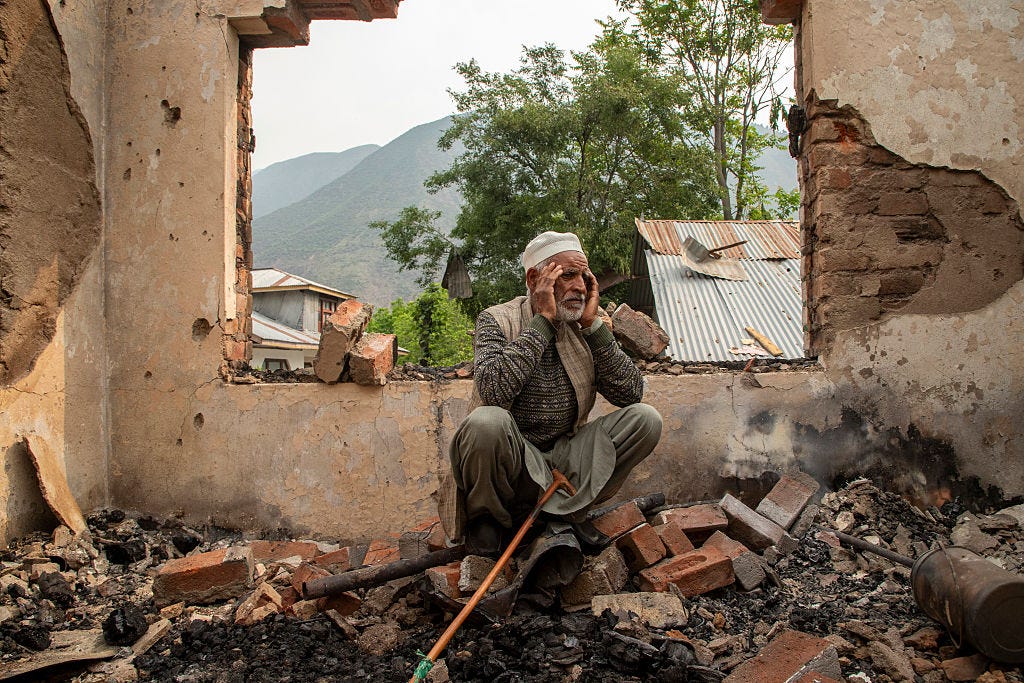The Kashmir Dilemma
India and Pakistan just had their worst clash in decades. History suggests the hostility won’t die down any time soon.

Skeptics say a ceasefire means no more than postponing a return to war. Even so, there is reason for a frazzled world to exhale now that India and Pakistan have called time on days of intensifying military conflict.
Last week, for the first time in half a century, the nuclear-armed neighbors struck deep into each other’s territory, launching drones and ballistic missiles that reached densely populated cities with adjacent military bases. It was an alarming escalation compared to the comparatively calibrated conduct of their most recent skirmishes between 2016 and 2019. Those had been limited to the border areas, including in disputed Kashmir. This time was dangerously different. It only came to an end on Saturday, with Donald Trump claiming the United States brokered a ceasefire deal that, for now, seems to be holding. (Top military officials from both sides spoke today to discuss the finer details of the truce.)
The proximate cause of the violence was a brutal terrorist attack in the picturesque tourist town of Pahalgam in Indian-administered Kashmir. The April 22 massacre of 26 civilians, including a young naval officer honeymooning with his wife of six days, had many Indians baying for revenge. There was particular horror when survivors recounted that many of the victims were asked if they were Hindu before being shot point blank.
A fortnight later, India launched nine “precision strikes” across Kashmir’s de facto border, as well as into Pakistan’s most populous and economically important province of Punjab. India said its target was “terrorist infrastructure” in Pakistan, whose existence the latter vehemently denied. India has refused to present evidence of its claims that the Pakistani state was involved in the Pahalgam massacre.
But when a little-known Kashmir-based group called The Resistance Front took responsibility, India was quick to link it with Lashkar-e-Taiba (LeT), whose umbilical connection with Pakistan is undeniable. Founded in the 1980s in Pakistan, LeT is designated a terrorist group by many countries. The UN says it has conducted “numerous terrorist operations” against military and civilian targets, including a December 2001 attack on India’s parliament. Pakistan has tacitly confirmed LeT links to past violence in India, but it says the group was outlawed and disbanded several years ago.
Along with targeting the LeT, India struck Pakistani sites it says are linked to Jaish e-Mohammed (JeM). Classified a terrorist organization by the United States and the UN Security Council in 2001, and banned by Pakistan itself in 2002, JeM is blamed for multiple atrocities in Kashmir. These include the 2019 suicide bombing of an Indian military convoy that killed 40 soldiers and brought India and Pakistan into a brief and scary conflict somewhat like the most recent eruption. Then, too, a new line was crossed in the bilateral relationship, with India dispatching warplanes into Pakistan-administered Kashmir in hot pursuit of JeM.
Indeed, Pakistan’s record on terrorism is well documented, with several of its own leaders admitting various degrees of culpability even as they insist that’s all in the past. Its most infamous terrorist link was Osama bin Laden, who was hunted down by the United States less than a mile from the Pakistan Military Academy in Abbottabad in 2011. During a 2019 visit to the United States, then-prime minister Imran Khan lamented that previous [Pakistani] governments had not acted against the “30,000 to 40,000 armed people [still in the country] who have been trained and fought in some part of Afghanistan or Kashmir.”
While nobody has proven a link between Pakistan’s government and the recent terrorist atrocity, this record looms large.
Following the massacre, both sides mobilized along religious lines. India chose an emotive name for its campaign: “Operation Sindoor.” Referencing the vermilion powder worn by married Hindu women in the parting of their hair, it evoked a traumatic image for Indians: a newly-widowed bride weeping beside her husband’s body in Pahalgam. Pakistan, meanwhile, named its military operation “Bunyan al-Marsoos,” an Arabic phrase meaning “a structure made of lead” that comes from a verse in the Quran. Pakistan’s army chief has spoken publicly of what he perceives as the deep differences between Hindus and Muslims.
This speaks to the deeper cause of the recent fighting: the unfinished business of partition. India and Pakistan are yoked together by history, geography, language, food, and shared memories of fighting colonial rule. Every August, one day apart, both mark their independence from the British. For newly-created Muslim-majority Pakistan, it was a blessed liberation. To constitutionally secular, Hindu-majority India, the loss of Pakistan was a painful amputation. Each side laid claim to the Himalayan region of Kashmir and has fought three of their four wars over it.
In 1947, Kashmir, a Muslim-majority state with a Hindu king, wanted to be independent rather than join India or Pakistan. But when Pakistan sent in tribal fighters to help persuade Kashmir to reconsider, the king asked India for help and agreed to join the Indian union. Pakistan regarded this as an injustice because it was founded as a homeland for South Asia’s Muslims. India saw it as reaffirmation of its secular credentials.
Within months they were at war over Kashmir—a war that was never properly resolved, with both sides merely stopping in their tracks. The line of control became the de facto border. India took the issue to the United Nations Security Council, which called for a plebiscite to let Kashmiris themselves decide which country they would rather join, but this was never held. The result has been a frozen conflict that—as we saw last week—periodically heats up (in the late 1980s, a violent separatist movement encouraged by Pakistan turned the beautiful valleys of the Indian part of Kashmir into killing fields.)
The subsequent decades saw a gradual building of tensions that brought the region to the latest round of conflict. In August 2019, following a campaign pledge by Prime Minister Narendra Modi, India revoked the special constitutional status afforded to the Indian-administered part of Kashmir (around two-thirds of the territory) and enfolded it more tightly within the embrace of the federal state. Jammu and Kashmir would no longer be a state but directly administered by Delhi. It would not have its own constitution and flag, nor the ability to remain demographically distinct because of restrictions on non-residents buying property there. In order to administer Kashmir from Delhi, Modi’s government installed a huge security presence, cracked down hard on dissent, and arbitrarily cut off internet and mobile networks for months on end. This has fueled profound local discontent.
Some discern an insidious agenda in the dramatic change to Kashmir’s status—one that will only fuel further violence. Is it an attempt to absorb Kashmir, India’s only Muslim-majority state, and subsume its sense of self as a unique region inhabited by a people with a distinctive culture? With residency permits being granted to non-Kashmiris, the argument goes, an influx of settlers from other parts of India will surely change the region forever, rather like the Han Chinese who surged into Tibet in the last half-century. The terrorist group India blames for the Pahalgam attack has said that’s exactly how it sees it.
The Kashmir impasse makes it hard to see a sunny prospect for the India-Pakistan relationship unless the ceasefire announced last week is converted into a bilateral move out of the trenches and to the diplomatic table. That didn’t happen after the 2019 skirmish. Until it does, the outlook is never-ending conflict—mostly muted, but with violent flare-ups, and the possibility of a nuclear confrontation never ruled out.
The situation is fluid and both nuclear-armed countries know the high stakes involved. In this long-running kabuki performance, they may find a way to exit the stage with honor intact. Even so, the risks of catastrophic miscalculation linger and multiply every time India and Pakistan come to the brink.
Rashmee Roshan Lall, former editor of the Sunday Times of India, contributed to Making Sense of Modi’s India, HarperCollins India. Her Substack is This Week, Those Books.
Follow Persuasion on X, LinkedIn, and YouTube to keep up with our latest articles, podcasts, and events, as well as updates from excellent writers across our network.
And, to receive pieces like this in your inbox and support our work, subscribe below:





This article is painfully inconsistent. It is clear that the Pakistani state has failed to protect both its own citizens (of which magnitudes more are killed every year compared to cross border terrorism), and encouraged terrorism in India as well -- there is simply no other way for a terrorist group to live and operate out of India. Therefore, terrorist groups in Pakistan survive either as a result of government incompetence, or active encouragement, either of which justifies retaliation from India. It is a fair question to ask who or what have the Indian army targeted, but to suggest the innocence of the Pakistani establishment is quite silly.
The article also suggests that the attacks are a result of Kashmiri dissatisfaction with the Indian state. There are deep insecurities between the Kashmiri people and the Indian state. However, most Kashmiris rely on the development of the Indian state for their wellbeing, not the terrorists or the Pakistani state. Now, after having recognized that (and the absolute domination of the Indian army on Kashmir -- which the article alludes), why would any Kashmiri attempt to cause more chaos and confusion -- a worse outcome for every one of his fellow Kashmiris?
Edward Luttwak on X asks why Pakistan, despite India being five-six times its size, and 11 times its economy, attacks India (https://x.com/ELuttwak/status/1921288453330768036). And concludes "Because of Islam's promise of victory." India has border dispute with China too, and in 1960s the two economies were about the same. Despite that no one in India went: "it would be a great idea to train and finance Uyghurs separatists to carry out terrorist activities in China." Imagine if that were to happen; how do you think China will respond?
Pakistan as a nation is obsessed with India; they just can't let it go. Their leaders, as a consequence, cannot pursue policies that benefit Pakistanis. You will not find one Pakistani intellectual or journalist make the case for freezing the Kashmir issue for 10 years, and just focus on economic growth, and wind down terrorist organizations in Pakistan.
Getting an unfair deal (Kashmir) is not justification for destroying your economy and politics for over a generation.
Regarding the hardships faced by Kashmiris: people forget that Kashmir also had a Hindu minority called the Kashmiri Pandits. They have all left Kashmir now after muslim militants had started to kill them in late 1980s, when, as the author mentions " violent separatist movement encouraged by Pakistan turned the beautiful valleys of the Indian part of Kashmir into killing fields." Chief Minister of Kashmir (top elected state official) has always been a muslim, and majority of the voters have also been muslims. I can understand if armed militancy was the only way for Kashmiris discontent to be addressed, but why couldn't they accomplish their goals through the ballot box?